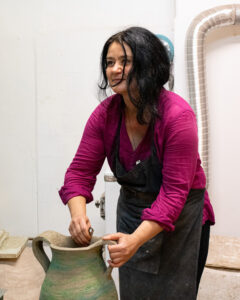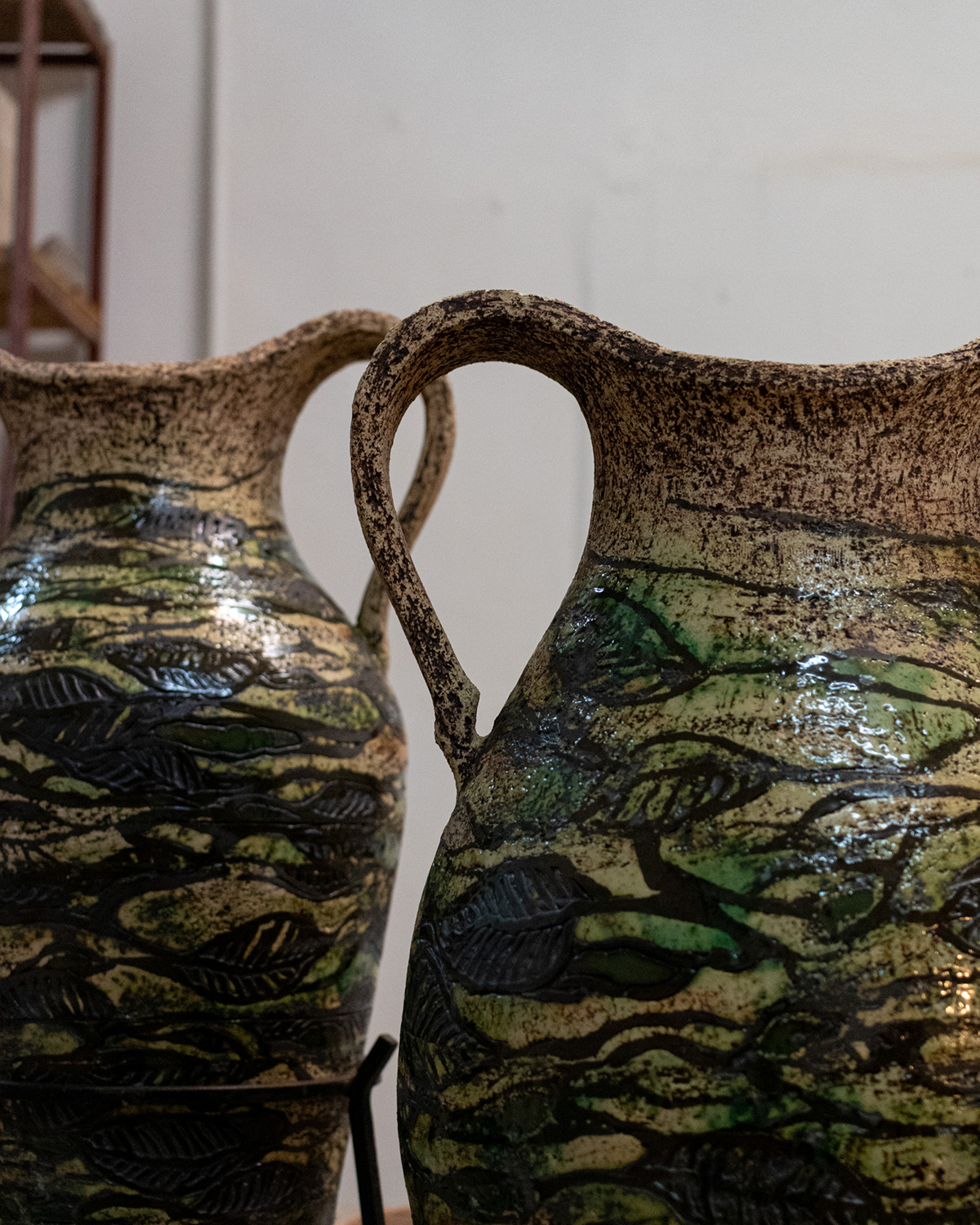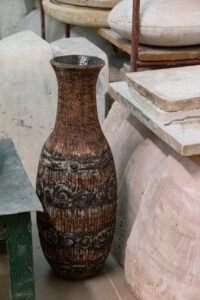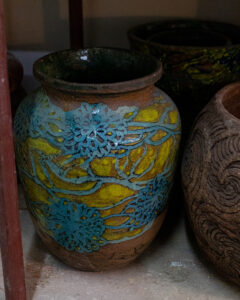
Doina Stici has an unmistakable, robust, telluric and at the same time graceful style of her artistic or environmental works, with an impressive record of solo exhibitions and national and international participations in events dedicated to ceramics.
The artist comes from a family of intellectuals from Chisinau and was initially oriented towards a musical career. Excessive shyness in front of the public became a serious impediment to this option, so her father suggested that she take up fine arts, after she had shown a penchant for ceramics in her teenage years. Father’s intuition proved to be excellent.
About Doina it can be said that it is a native talent combined with a deep reflective capacity and prolific experience both in the industrial area and in her personal workshop. When he works on an amphora, his hands move with such confidence and ease on the chamois, as if they were those of a skillful weaver in Persia, rather than those of an artist working with ceramic material. The form and motifs of his vases carry ancient echoes and appear animated, like characters in an epic or lyrical discourse.

When did you first think or set out to become a ceramist?
Things have come together.
I didn’t go to art high school, I went to a theoretical high school, and in parallel with high school I went to music school. That school was very good, most of the students who graduated went on to study at the conservatory. But I had a problem, I was too emotional. In my last exam at music school I was playing a Bach fugue on the piano, and I made several mistakes due to nervousness. During the rehearsals everything was going well, but with the audience in front of me and the jury, I broke down. This was a test too. It was suggested to my parents to direct me to something else.
Also in parallel with high school and music school, in the evenings, I went to some pottery classes for teenagers. To convince me that I could do ceramics at university, that I could continue my studies in this direction, my father collected all the clay objects I had made, he put them in front of me and said: ‘you can do fine arts’.
I graduated from the Academy of Visual Arts in Cluj. After college, but also during it, starting with my second year, I made and sold several ceramic objects at the UAP galleries and private galleries in Cluj. When I was doing my master’s studies, I got a bigger order, more big pots for the garden. Shortly after graduating from college, I had my first personal exhibition of ceramics… and so on and so forth, I found myself modelling something almost every day to earn a living, from everything I made I selected the most successful objects and exhibited them… at a certain point I felt like I was on tour!, organizing personal exhibitions in the country or participating in group exhibitions and specialized fairs.
At exhibitions, at openings I was presented and catalogued by critics and curators as a ceramic artist, then I realized that this is what I became, a visual artist, a ceramist. Articles about my creation appeared in the press, I was invited to several programs dedicated to ceramics, I was selling ceramics from exhibitions and art fairs, then I realized that, yes! the ceramics I was making were appreciated.
Have I ever wanted to be a ceramist? It happened.
Can you tell us about what it was like and how you felt when you participated for the first time in a ceramics exhibition?
I organized my first personal ceramics exhibition in Cluj, in 2000. There used to be a private art gallery, “Alliance of Arts” – a spacious gallery with arcades and an inner courtyard – at the end of the gang near the “Carpathian” coffee shop. I was quite overwhelmed by the responsibility I had taken on, organizing a solo exhibition is not an easy thing. I had no time for myself, no time for sensations or whims, I could barely eat. I had to set up the exhibition, two big halls, I had to think and act, to act as constructively as possible.
I had training for these situations. At the Academy of Visual Arts I had four or five themes per semester, to be made in ceramic material and exhibited, a more advanced stage I passed with the diploma and master’s thesis, until the solo exhibition at the “Alliance of Arts” I had participated in several group exhibitions of ceramics and as I usually did, I concentrated to the maximum so that, willy-nilly I forgot about myself, because I had no time for myself.
What do you like to be called, ceramicist, potter or visual artist and why?
Ceramist. I like that word.
Confusingly, ceramists are also called ceramic workers in ceramics factories. And the workers who weave baskets from porcelain, they also make ceramics, they are also potters.
If they call me a potter, I don’t like it. There is another confusion, often popular pottery created by craftsmen is confused with artistic pottery. Craftsmen borrow designs from their predecessors. In other words: the first potter in the village was an artist, the other potters borrowed his designs and decorating techniques, enriching them.
By repeating decorative patterns and the shapes of the objects they created pottery traditional to a particular place, region.
In addition, the word “potter” brings to mind only functional, utilitarian objects. And a ceramic artist, as well as being an inventor and creator of the shapes of utilitarian objects, pots, mugs, plates and so on, can translate thoughts, feelings, ideas, sensations into ceramic material. A ceramic artist is like a poet who writes poetry, but the material through which he expresses himself is not the letter of the word but the ceramic material.
The ceramic artist translates his ideas into ceramic material, the visual artist, however, in addition to ceramic material, can translate them into any other material, paper, bronze, plastic, drawing, textiles and so on, has total freedom in the choice of materials in which to write his “verses”.
What does ceramics mean to you?
Ceramics for me is not a job. I don’t go to the workshop like I go to work. I go to the workshop because I always have something to do, to model, to color, to think. That something is part of me. Ceramics for me is a professional activity but also a way of being.

What do you think is the most important quality of ceramic art?
The ways of expression are multiple – I can express myself verbally or in writing, I can express myself singing, dancing. Ceramics is also a way of expression. Through modeling, through colors and shapes, through my creation, I express myself, I transmit information to people, to the public, this seems to me to be the most important quality of ceramics and art in general, nonverbal communication through tangible objects. A visual art form of expression. I develop my creation, I focus on creating works that take place in the environment that you see, the visible environment. This is how visual artists express themselves.
What are your sources of inspiration?
When and how. For example, I found a sketch of mine with stylized apple trees in an old notebook. Since then I visualize a work, like an installation with these trees, I visualize what they would look like in ceramics in different color variations. I keep thinking about how I could make this work technically correct, the dimensions, the material, how this work would look in a garden, in a room or exhibition hall. My sources of inspiration? Apples on the table. At other times I go to the library and feed my eyes, art magazines of ceramics, sculpture, design, I browse, I look a lot at computer images, the environment and the artistic vision of things, of life, of events, that’s what I’m looking for, that’s what I need. If they don’t end up in libraries, that’s fine then too, food for the eyes can be found everywhere, especially in nature.

Which ceramic materials do you like to use most and why?
I like Shamota a lot. It’s tough, grainy, sculptural, docile, easy to work with. Shamot is a material made from fired and ground clay. Refractory products are made from chamotte in factories for metal foundries or in the form of bricks for furnaces, stoves, chimneys in houses. I like porcelain too, although it’s quite fussy, moody, cracks, warps when you expect it and when you don’t. It gives me a lot of trouble, but I like it.
I use these two materials more often. Use them separately or combine them. For example, as a decoration for the pots I make, I weave a porcelain yarn weave on the surface of the shamot or vice versa, on the porcelain surface I impregnate the shamot weave.
It’s not fair if I say I work with shamota, in my case. Shamota is of many kinds, combinations, compositions, compositions, colors, burned at different temperatures. It would be fair to say that I work with shamote. It’s the same with porcelain, I don’t work with porcelain, I work with porcelain.
Of course I also work with clay, but less often.

Do you use more industrial techniques and technologies dedicated to ceramics or more manual working techniques? What do you think are their pros and cons?
Well, for example, I can make porcelain wires by hand, it’s simple, I roll the porcelain with my palm or with my fingers on a wooden or plaster board. I roll it slowly until I get the desired thickness for the porcelain thread, it takes about a minute. In the industrial version there is a press, extruder, with the help of this tool, by pressing, in a few seconds, I get a porcelain thread with a uniform surface and thickness. The pros and cons? The hand-wound yarn is far from perfect, the press-wound one is flawless, plus I got this one much faster.
In my workshop I use industrial techniques such as pressing and molding in plaster molds and hand techniques, of course, construction modeling and slab modeling, on a case by case basis, depending on the job or jobs I have to do.
How would you describe your job in three words?
The Furnace Burns Lyrics.
What do you think are three of the most important qualities a visual artist should have?
Talent, hard work, perseverance.
Interview by Letiția Câmpan.
